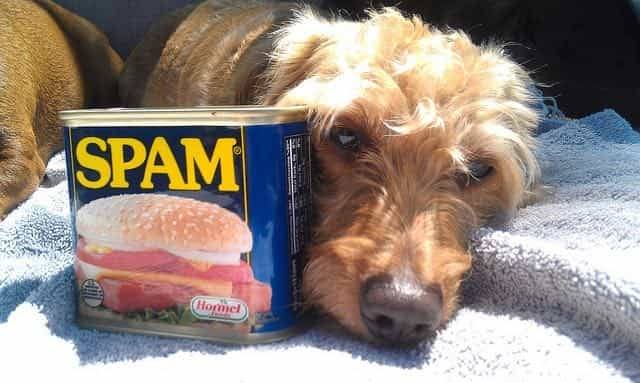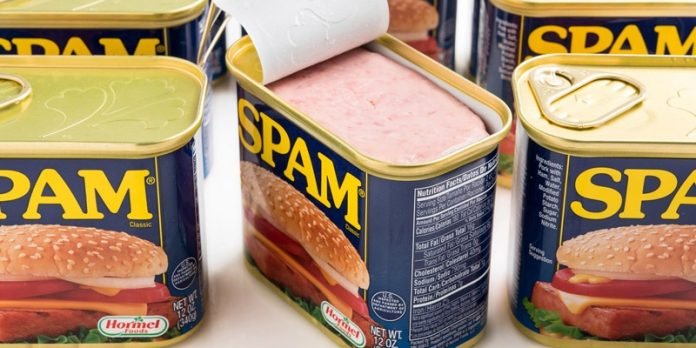Dogs should not eat spam since spam contains too much salt and saturated fats.
With dogs being carnivores, they love to eat all kinds of meat, including pork. As such, a can of spam may seem like the best option for your dog when you run out of Keeble or when you want to switch up the taste for your dog. But let’s look at why it’s not safe for your mutt to eat this canned pork meat…
Precise Answer: Can Dogs Eat Spam
Just like other highly processed foods for humans, dogs should never eat spam as a treat or as part of their daily diet routine. Though the main ingredients in spam are ham and pork shoulder meat, they contain a high amount of saturated fats and salt. These substances are highly toxic to dogs and result in different health complications.
Aside from salt and saturated fats, span also contains nitrates, preservatives, and flavors such as garlic. These additives are extremely toxic and can make your dog vomit, diarrhea, and weaken the immune system. In some cases, it can quickly transition into a health emergency, especially if you feed spam to your puppy. That’s why it’s advisable to avoid feeding your dog spam completely. So can dogs eat spam? We certainly wouldn’t recommend it!
The Nutritional Value of Spam
Basically, spam is a cooked meat product created from processed ham and ground pork. The mixture is then combined with preservative and flavoring substances like salt, sugar, sodium nitrite, and potato start before it’s canned and vacuum-sealed.
Spam gained popularity during World War II for being cheap and a convenient alternative to natural food for soldiers overseas. However, the product is currently sold in stores all over the world, and it has become a household food item favored for its ease of preparation, versatility, convenience, and long shelf life.
This product is high in fat, calories, and sodium. However, it offers little proteins and a few other micronutrients such as iron, copper, potassium, and zinc, with each two-ounce (56 grams) serving to contain:
- 174 calories
- 7 grams of protein
- 2 grams of carbohydrates
- 16 grams of fat
- 75 grams of sodium
- 7% zinc
- 4% potassium
- 3% iron
- 3% copper
None of the ingredients in spam are known to be toxic to dogs, but its highly processed meat with extremely dangerous levels of nitrates and sodium. These salt levels are risky, as a fully grown dog weighing over 30 pounds should consume less than 100 mg of sodium per day. However, a tin of spam contains around 2,250 mg of sodium, and a large dog can easily finish the entire tin.
Effects of Feeding Spam to Your Dog
As earlier mentioned, spam is high in salt and fat, which can lead to several health complications in your dog.
High-fat foods are known to increase the risk of pancreatitis in dogs, though the danger levels highly depend on age, size, and breed of your dog.
On the other hand, excess salt can lead to salt poisoning as dogs can’t handle huge amounts of salt or human food spices.
Does Spam Predispose Your Dog to Pancreatitis?
Just like other high-fat foods, spam increases the risk of pancreatitis in dogs, a serious and often life-threatening issue in canines. However, that doesn’t mean that fat causes pancreatitis. The real issue occurs when the dog’s pancreas starts to swell, mainly due to eating a high-fat, high-carb diet.
So, What Exactly is Pancreatitis?
Pancreatitis refers to the inflammation of the pancreas, most common in cats and dogs. This life-threatening health condition also presents a myriad of other disease severities ranging mild to severe and acute to chronic.
When your dog is suffering from pancreatitis, the pancreas releases enzymes in the area surrounding the abdomen instead of the digestive tract. These enzymes cause localized inflammation of the pancreas and can lead to life-threatening complications. However, the condition can be acute or chronic depending on various factors, including your dog’s feeding habits.
- Acute Pancreatitis – This tends to occur suddenly after the dog eats fatty foods such as spam, pork, or other human junk foods. That means dogs that like to dig around in the trash can are at risk of developing pancreatitis
- Chronic Pancreatitis – This condition occurs after repeated instances of acute pancreatitis, though it’s not clear what causes it.
How to Know if Your Dog has Pancreatitis
Though your dog may not develop pancreatitis immediately after eating spam, it’s important for owners to stay informed about the condition before it strikes. It’s easy to mistake some of these signs for something less serious, despite the condition being life-threatening to your mutt. Here are the telltale signs that your dog may have pancreatitis:
- Repeated vomiting
- Hunched back (abnormal posture)
- Diarrhea
- Dehydration
- Loss of appetite
- Depression and tiredness (lethargy)
- Fever
If your dog is showing any of these signs after eating spam, monitor him/her throughout the day and note if it gets serious. However, if the dog exhibits several signs at once or repeatedly, consult your veterinarian immediately before giving the dog any supplements for the condition.
Eating Spam May Cause Obesity in Dogs
Fats and oils are responsible for giving your dog healthy skin and improving the coating. The fats also provide energy and are necessary for body development, as well as the proper functioning of cells, muscles, and tissues. However, eating too much fat isn’t healthy for your dog. In fact, the fat allowance for a healthy adult dog is about 3.3g/MJ of the metabolizable energy, also equivalent to 5% of fat weight in dry food (1.5MJ per 100grams).
With spam containing more than 15grams of fat per serving, the excess fat puts your dog at the risk of getting obese. This nutritional disease can affect dogs of all ages, but it’s quite common in middle-aged dogs which tend to eat too much food. The symptoms include:
- Weight gain
- Unwillingness or inability to exercise and decreased stamina
- Excess body fat
- Breathing difficulty (respiratory compromise)
Obesity in dogs is also known to cause other health complications, including diabetes, hypertension, liver disease, and pancreatitis, to name a few. Talk to your veterinarian on how to alleviate the damage, if your dog is already obese.
Spam and Salt Poisoning
While humans find salt to be very tasty and a crucial ingredient in most kitchens, it can be very dangerous for your dog, especially in large quantities. Spam has a high amount of salt, making it quite dangerous for your dog. Too much salt will quickly result in dehydration in dogs, but your dog may be ok if he takes plenty of fresh water.
With some dog breeds, too much salt will quickly put your mutt in a serious medical emergency. That will make you wonder, “How much salt can my dog eat?” Let’s explain!
How much is too much salt for your Dog?
According to the recommendations made by the US Agricultural and Natural Resources Board, a healthy dog (about 33 pounds) should not consume more than 1gram of sodium in a day. That means your dog will start developing salt poisoning issues if he/she consumes more than one spam serving in a day. However, the salt tolerance level in dogs might vary depending on the breed, underlying health conditions, and age.
To know exactly how much salt your dog can take in a day, consult your vet, and also inquire whether your mutt can have spam as a treat. Some veterinarians recommend that dogs shouldn’t eat more than 1.5 grams per pound of their average body weight per day, though your dog’s medical condition will need to be considered.
If your dog consumes too much salt, the first sign that you can quickly note is that your furry friend is taking in too much water. Your pet may seem overly tired, seem somehow stiff, and have a swollen stomach. Here are all the signs you will want to be on the lookout for to know when your dog is suffering from salt poisoning.
Signs of salt poisoning in dogs include:
- Lack of energy
- Frequent urination extreme thirst
- Loss of appetite
- Convulsions
- Seizures
- Confusion
- Vomiting
- Nausea
- Watery diarrhea
- Weakness
- Increased heart rate
- Comma in serious situations
If your dog is showing one or two of the above signs, give him/her plenty of fresh water and observe throughout the day to see if anything changes. However, if the dog is showing numerous signs, we advise you to give your vet a visit.
Final Thoughts
So, we hope we fully answered can dogs eat spam? Do you still think your dog can eat spam? Well, the dog might like the taste, and it may seem like a convenient treat, but it’s extremely rich in saturated fats and salt, which should never be included in your dog’s diet intentionally. Dogs will have a problem with any human food that contains a high percentage of sodium, and hence, it should be avoided at all costs.
We recommend putting your dog on a natural raw food diet and some tasty homemade treats prepared to create a balance in the dog’s diet. You can also consult your vet on how to create a healthy food diet for your dog.


























